Organizational Behavior Analysis: Google's Culture, Politics, Teams
VerifiedAdded on 2020/12/24
|12
|3318
|152
Report
AI Summary
This report provides an in-depth analysis of Google's organizational behavior, examining how organizational culture, politics, and power influence individual and team performance. It delves into content and process theories of motivation, including Maslow's Hierarchy, ERG Theory, Equity Theory, and Expectancy Theory, along with various motivational techniques like compensation and recognition. The report then explores the characteristics of effective and ineffective teams, outlining different team types and the Tuckman Model of team development. Finally, it applies organizational behavior concepts and philosophies to Google's specific context, offering a comprehensive overview of the company's approach to managing its workforce and achieving its goals. The report emphasizes the importance of a positive work environment, effective leadership, and employee engagement for organizational success.
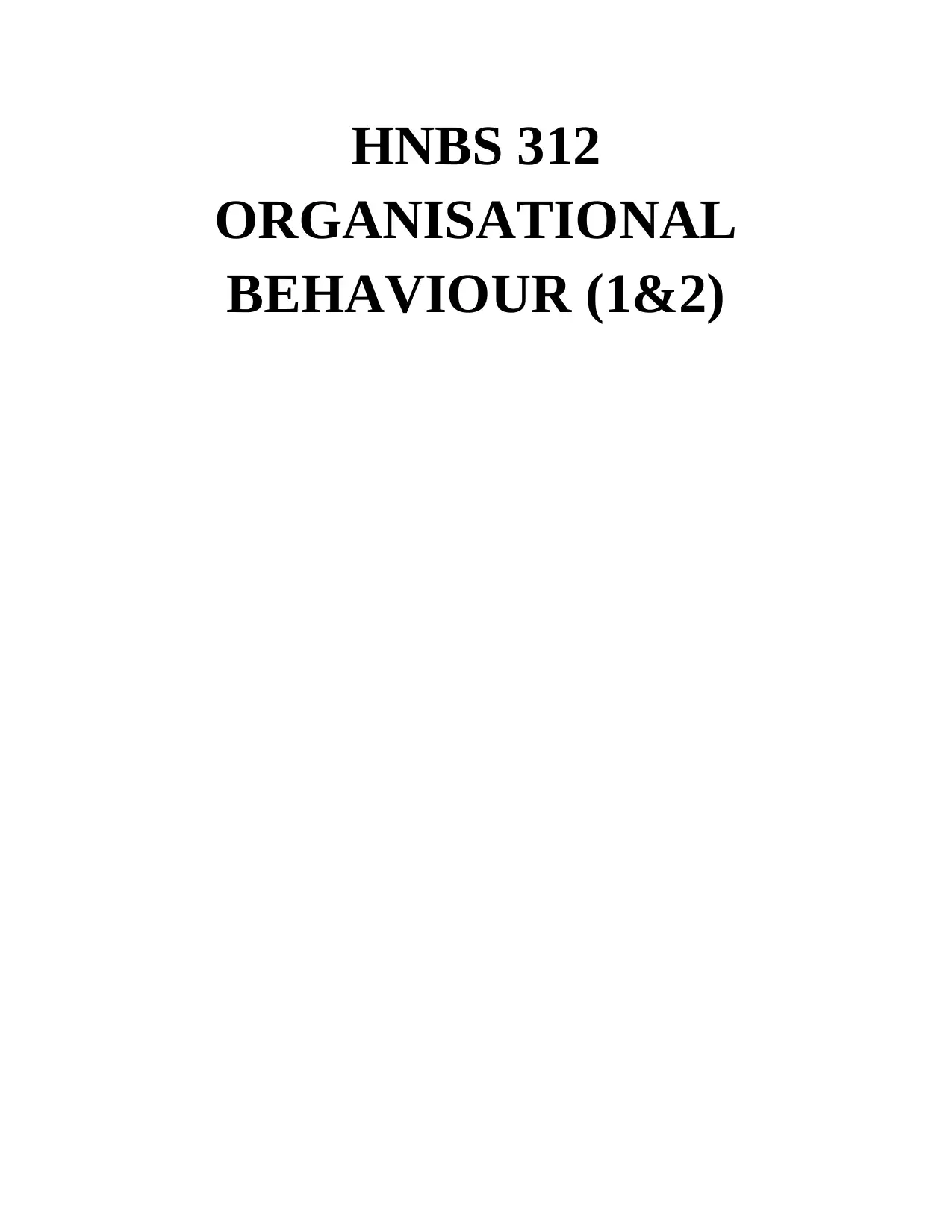
HNBS 312
ORGANISATIONAL
BEHAVIOUR (1&2)
ORGANISATIONAL
BEHAVIOUR (1&2)
Paraphrase This Document
Need a fresh take? Get an instant paraphrase of this document with our AI Paraphraser
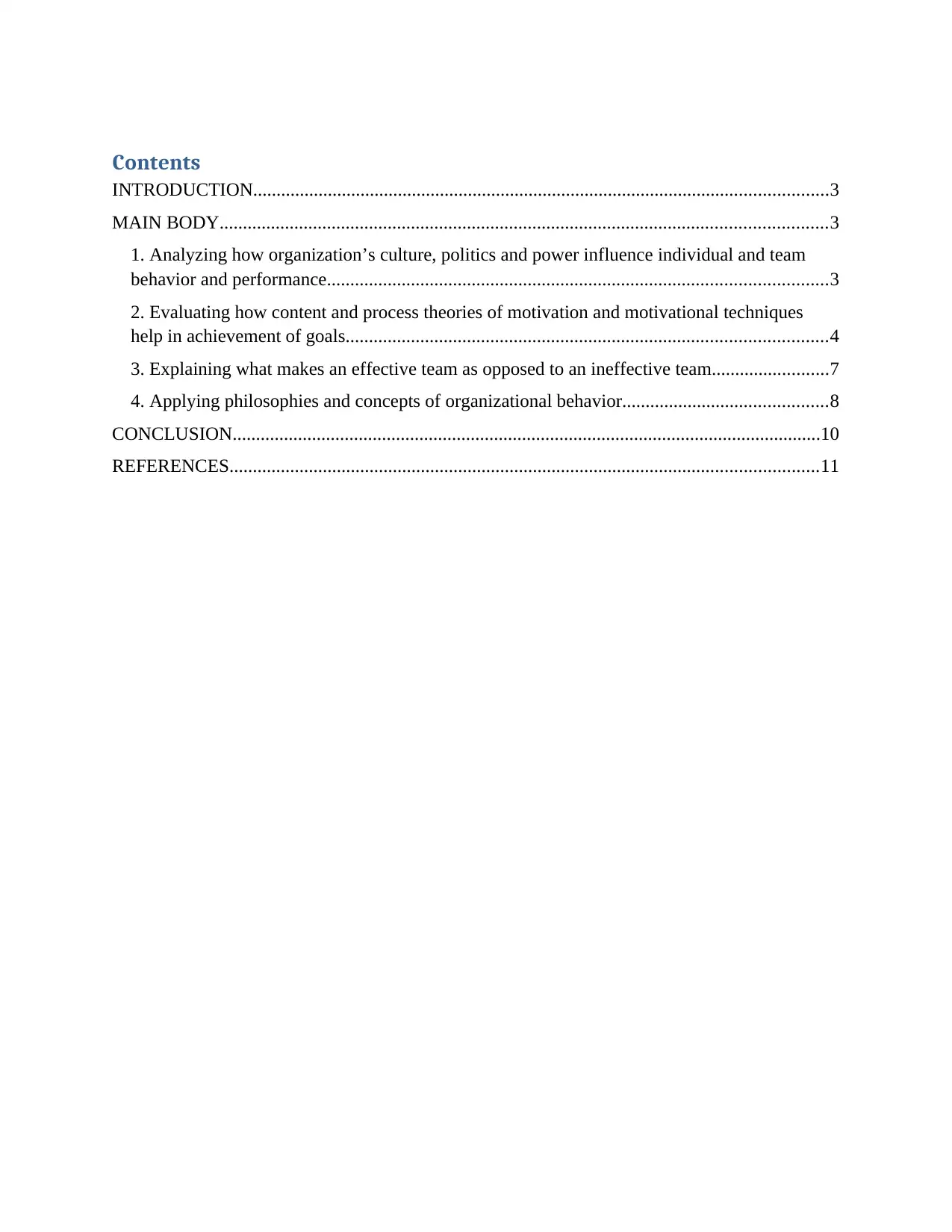
Contents
INTRODUCTION...........................................................................................................................3
MAIN BODY..................................................................................................................................3
1. Analyzing how organization’s culture, politics and power influence individual and team
behavior and performance...........................................................................................................3
2. Evaluating how content and process theories of motivation and motivational techniques
help in achievement of goals.......................................................................................................4
3. Explaining what makes an effective team as opposed to an ineffective team.........................7
4. Applying philosophies and concepts of organizational behavior............................................8
CONCLUSION..............................................................................................................................10
REFERENCES..............................................................................................................................11
INTRODUCTION...........................................................................................................................3
MAIN BODY..................................................................................................................................3
1. Analyzing how organization’s culture, politics and power influence individual and team
behavior and performance...........................................................................................................3
2. Evaluating how content and process theories of motivation and motivational techniques
help in achievement of goals.......................................................................................................4
3. Explaining what makes an effective team as opposed to an ineffective team.........................7
4. Applying philosophies and concepts of organizational behavior............................................8
CONCLUSION..............................................................................................................................10
REFERENCES..............................................................................................................................11
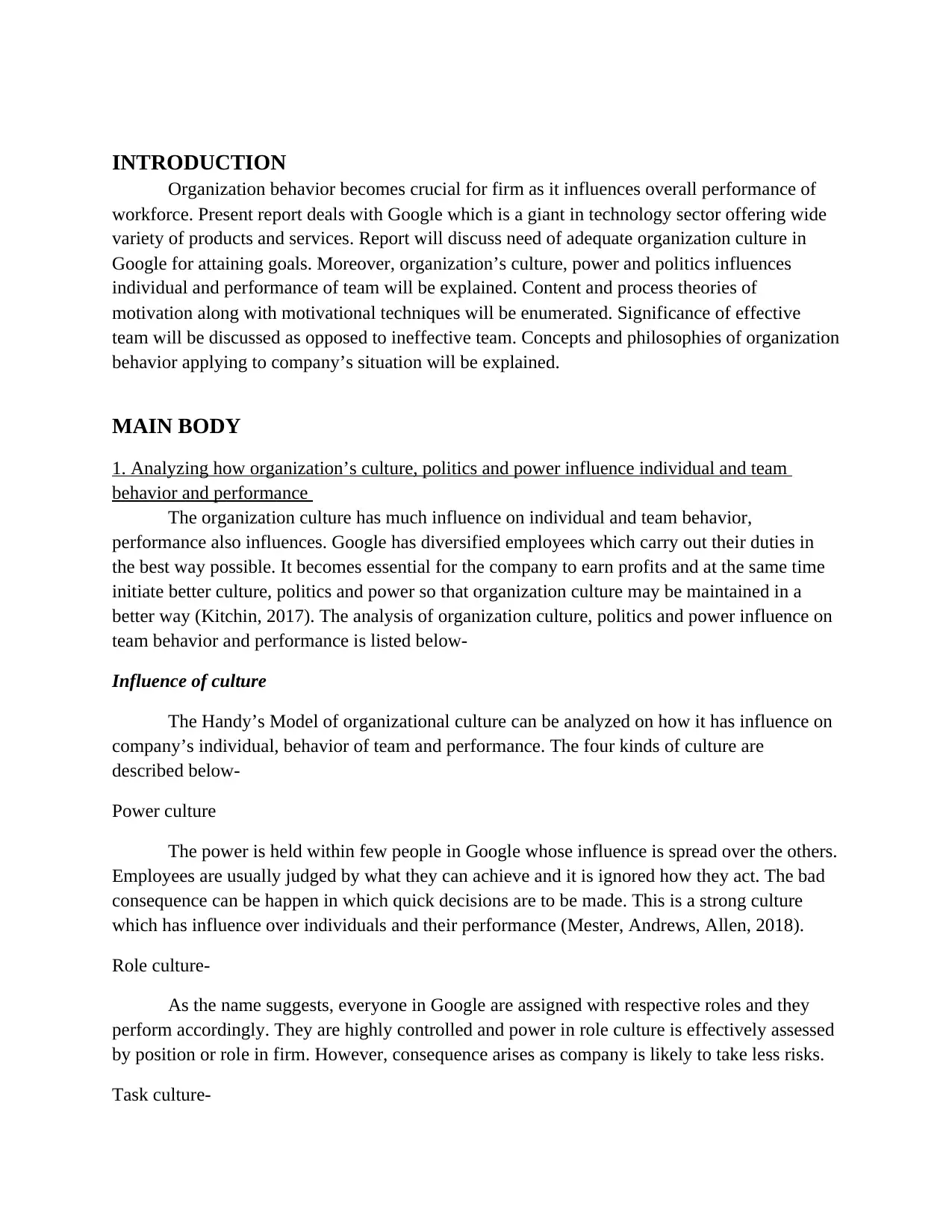
INTRODUCTION
Organization behavior becomes crucial for firm as it influences overall performance of
workforce. Present report deals with Google which is a giant in technology sector offering wide
variety of products and services. Report will discuss need of adequate organization culture in
Google for attaining goals. Moreover, organization’s culture, power and politics influences
individual and performance of team will be explained. Content and process theories of
motivation along with motivational techniques will be enumerated. Significance of effective
team will be discussed as opposed to ineffective team. Concepts and philosophies of organization
behavior applying to company’s situation will be explained.
MAIN BODY
1. Analyzing how organization’s culture, politics and power influence individual and team
behavior and performance
The organization culture has much influence on individual and team behavior,
performance also influences. Google has diversified employees which carry out their duties in
the best way possible. It becomes essential for the company to earn profits and at the same time
initiate better culture, politics and power so that organization culture may be maintained in a
better way (Kitchin, 2017). The analysis of organization culture, politics and power influence on
team behavior and performance is listed below-
Influence of culture
The Handy’s Model of organizational culture can be analyzed on how it has influence on
company’s individual, behavior of team and performance. The four kinds of culture are
described below-
Power culture
The power is held within few people in Google whose influence is spread over the others.
Employees are usually judged by what they can achieve and it is ignored how they act. The bad
consequence can be happen in which quick decisions are to be made. This is a strong culture
which has influence over individuals and their performance (Mester, Andrews, Allen, 2018).
Role culture-
As the name suggests, everyone in Google are assigned with respective roles and they
perform accordingly. They are highly controlled and power in role culture is effectively assessed
by position or role in firm. However, consequence arises as company is likely to take less risks.
Task culture-
Organization behavior becomes crucial for firm as it influences overall performance of
workforce. Present report deals with Google which is a giant in technology sector offering wide
variety of products and services. Report will discuss need of adequate organization culture in
Google for attaining goals. Moreover, organization’s culture, power and politics influences
individual and performance of team will be explained. Content and process theories of
motivation along with motivational techniques will be enumerated. Significance of effective
team will be discussed as opposed to ineffective team. Concepts and philosophies of organization
behavior applying to company’s situation will be explained.
MAIN BODY
1. Analyzing how organization’s culture, politics and power influence individual and team
behavior and performance
The organization culture has much influence on individual and team behavior,
performance also influences. Google has diversified employees which carry out their duties in
the best way possible. It becomes essential for the company to earn profits and at the same time
initiate better culture, politics and power so that organization culture may be maintained in a
better way (Kitchin, 2017). The analysis of organization culture, politics and power influence on
team behavior and performance is listed below-
Influence of culture
The Handy’s Model of organizational culture can be analyzed on how it has influence on
company’s individual, behavior of team and performance. The four kinds of culture are
described below-
Power culture
The power is held within few people in Google whose influence is spread over the others.
Employees are usually judged by what they can achieve and it is ignored how they act. The bad
consequence can be happen in which quick decisions are to be made. This is a strong culture
which has influence over individuals and their performance (Mester, Andrews, Allen, 2018).
Role culture-
As the name suggests, everyone in Google are assigned with respective roles and they
perform accordingly. They are highly controlled and power in role culture is effectively assessed
by position or role in firm. However, consequence arises as company is likely to take less risks.
Task culture-
⊘ This is a preview!⊘
Do you want full access?
Subscribe today to unlock all pages.

Trusted by 1+ million students worldwide
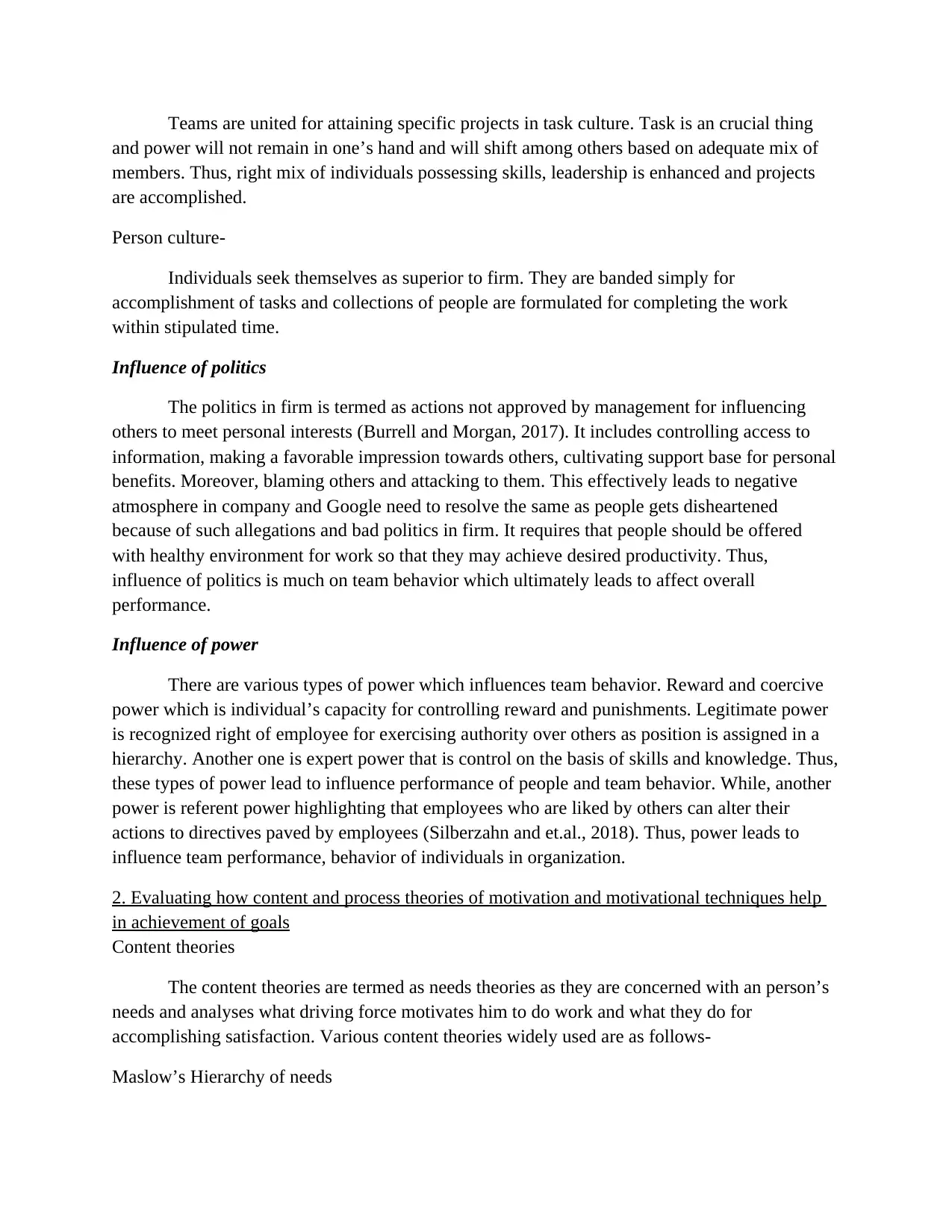
Teams are united for attaining specific projects in task culture. Task is an crucial thing
and power will not remain in one’s hand and will shift among others based on adequate mix of
members. Thus, right mix of individuals possessing skills, leadership is enhanced and projects
are accomplished.
Person culture-
Individuals seek themselves as superior to firm. They are banded simply for
accomplishment of tasks and collections of people are formulated for completing the work
within stipulated time.
Influence of politics
The politics in firm is termed as actions not approved by management for influencing
others to meet personal interests (Burrell and Morgan, 2017). It includes controlling access to
information, making a favorable impression towards others, cultivating support base for personal
benefits. Moreover, blaming others and attacking to them. This effectively leads to negative
atmosphere in company and Google need to resolve the same as people gets disheartened
because of such allegations and bad politics in firm. It requires that people should be offered
with healthy environment for work so that they may achieve desired productivity. Thus,
influence of politics is much on team behavior which ultimately leads to affect overall
performance.
Influence of power
There are various types of power which influences team behavior. Reward and coercive
power which is individual’s capacity for controlling reward and punishments. Legitimate power
is recognized right of employee for exercising authority over others as position is assigned in a
hierarchy. Another one is expert power that is control on the basis of skills and knowledge. Thus,
these types of power lead to influence performance of people and team behavior. While, another
power is referent power highlighting that employees who are liked by others can alter their
actions to directives paved by employees (Silberzahn and et.al., 2018). Thus, power leads to
influence team performance, behavior of individuals in organization.
2. Evaluating how content and process theories of motivation and motivational techniques help
in achievement of goals
Content theories
The content theories are termed as needs theories as they are concerned with an person’s
needs and analyses what driving force motivates him to do work and what they do for
accomplishing satisfaction. Various content theories widely used are as follows-
Maslow’s Hierarchy of needs
and power will not remain in one’s hand and will shift among others based on adequate mix of
members. Thus, right mix of individuals possessing skills, leadership is enhanced and projects
are accomplished.
Person culture-
Individuals seek themselves as superior to firm. They are banded simply for
accomplishment of tasks and collections of people are formulated for completing the work
within stipulated time.
Influence of politics
The politics in firm is termed as actions not approved by management for influencing
others to meet personal interests (Burrell and Morgan, 2017). It includes controlling access to
information, making a favorable impression towards others, cultivating support base for personal
benefits. Moreover, blaming others and attacking to them. This effectively leads to negative
atmosphere in company and Google need to resolve the same as people gets disheartened
because of such allegations and bad politics in firm. It requires that people should be offered
with healthy environment for work so that they may achieve desired productivity. Thus,
influence of politics is much on team behavior which ultimately leads to affect overall
performance.
Influence of power
There are various types of power which influences team behavior. Reward and coercive
power which is individual’s capacity for controlling reward and punishments. Legitimate power
is recognized right of employee for exercising authority over others as position is assigned in a
hierarchy. Another one is expert power that is control on the basis of skills and knowledge. Thus,
these types of power lead to influence performance of people and team behavior. While, another
power is referent power highlighting that employees who are liked by others can alter their
actions to directives paved by employees (Silberzahn and et.al., 2018). Thus, power leads to
influence team performance, behavior of individuals in organization.
2. Evaluating how content and process theories of motivation and motivational techniques help
in achievement of goals
Content theories
The content theories are termed as needs theories as they are concerned with an person’s
needs and analyses what driving force motivates him to do work and what they do for
accomplishing satisfaction. Various content theories widely used are as follows-
Maslow’s Hierarchy of needs
Paraphrase This Document
Need a fresh take? Get an instant paraphrase of this document with our AI Paraphraser
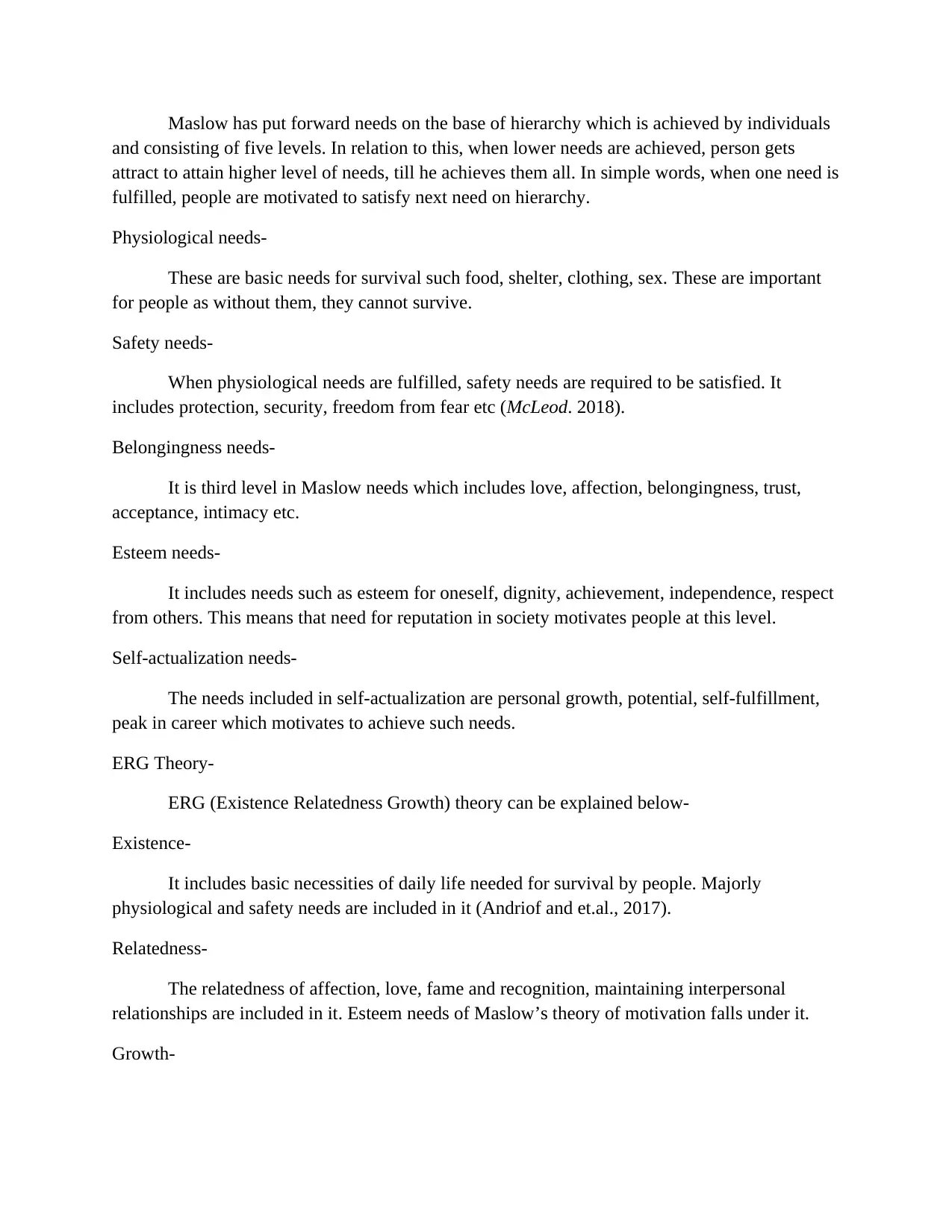
Maslow has put forward needs on the base of hierarchy which is achieved by individuals
and consisting of five levels. In relation to this, when lower needs are achieved, person gets
attract to attain higher level of needs, till he achieves them all. In simple words, when one need is
fulfilled, people are motivated to satisfy next need on hierarchy.
Physiological needs-
These are basic needs for survival such food, shelter, clothing, sex. These are important
for people as without them, they cannot survive.
Safety needs-
When physiological needs are fulfilled, safety needs are required to be satisfied. It
includes protection, security, freedom from fear etc (McLeod. 2018).
Belongingness needs-
It is third level in Maslow needs which includes love, affection, belongingness, trust,
acceptance, intimacy etc.
Esteem needs-
It includes needs such as esteem for oneself, dignity, achievement, independence, respect
from others. This means that need for reputation in society motivates people at this level.
Self-actualization needs-
The needs included in self-actualization are personal growth, potential, self-fulfillment,
peak in career which motivates to achieve such needs.
ERG Theory-
ERG (Existence Relatedness Growth) theory can be explained below-
Existence-
It includes basic necessities of daily life needed for survival by people. Majorly
physiological and safety needs are included in it (Andriof and et.al., 2017).
Relatedness-
The relatedness of affection, love, fame and recognition, maintaining interpersonal
relationships are included in it. Esteem needs of Maslow’s theory of motivation falls under it.
Growth-
and consisting of five levels. In relation to this, when lower needs are achieved, person gets
attract to attain higher level of needs, till he achieves them all. In simple words, when one need is
fulfilled, people are motivated to satisfy next need on hierarchy.
Physiological needs-
These are basic needs for survival such food, shelter, clothing, sex. These are important
for people as without them, they cannot survive.
Safety needs-
When physiological needs are fulfilled, safety needs are required to be satisfied. It
includes protection, security, freedom from fear etc (McLeod. 2018).
Belongingness needs-
It is third level in Maslow needs which includes love, affection, belongingness, trust,
acceptance, intimacy etc.
Esteem needs-
It includes needs such as esteem for oneself, dignity, achievement, independence, respect
from others. This means that need for reputation in society motivates people at this level.
Self-actualization needs-
The needs included in self-actualization are personal growth, potential, self-fulfillment,
peak in career which motivates to achieve such needs.
ERG Theory-
ERG (Existence Relatedness Growth) theory can be explained below-
Existence-
It includes basic necessities of daily life needed for survival by people. Majorly
physiological and safety needs are included in it (Andriof and et.al., 2017).
Relatedness-
The relatedness of affection, love, fame and recognition, maintaining interpersonal
relationships are included in it. Esteem needs of Maslow’s theory of motivation falls under it.
Growth-
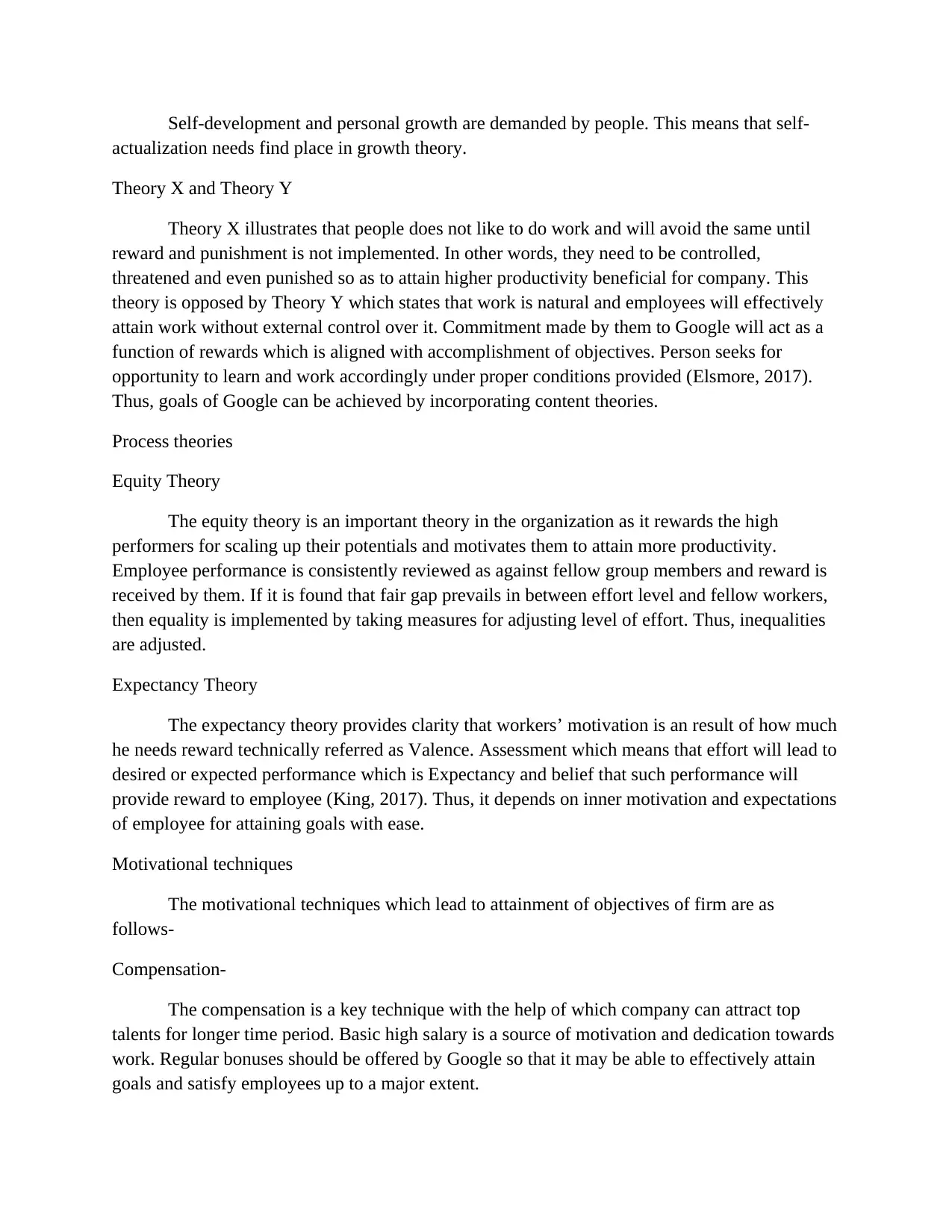
Self-development and personal growth are demanded by people. This means that self-
actualization needs find place in growth theory.
Theory X and Theory Y
Theory X illustrates that people does not like to do work and will avoid the same until
reward and punishment is not implemented. In other words, they need to be controlled,
threatened and even punished so as to attain higher productivity beneficial for company. This
theory is opposed by Theory Y which states that work is natural and employees will effectively
attain work without external control over it. Commitment made by them to Google will act as a
function of rewards which is aligned with accomplishment of objectives. Person seeks for
opportunity to learn and work accordingly under proper conditions provided (Elsmore, 2017).
Thus, goals of Google can be achieved by incorporating content theories.
Process theories
Equity Theory
The equity theory is an important theory in the organization as it rewards the high
performers for scaling up their potentials and motivates them to attain more productivity.
Employee performance is consistently reviewed as against fellow group members and reward is
received by them. If it is found that fair gap prevails in between effort level and fellow workers,
then equality is implemented by taking measures for adjusting level of effort. Thus, inequalities
are adjusted.
Expectancy Theory
The expectancy theory provides clarity that workers’ motivation is an result of how much
he needs reward technically referred as Valence. Assessment which means that effort will lead to
desired or expected performance which is Expectancy and belief that such performance will
provide reward to employee (King, 2017). Thus, it depends on inner motivation and expectations
of employee for attaining goals with ease.
Motivational techniques
The motivational techniques which lead to attainment of objectives of firm are as
follows-
Compensation-
The compensation is a key technique with the help of which company can attract top
talents for longer time period. Basic high salary is a source of motivation and dedication towards
work. Regular bonuses should be offered by Google so that it may be able to effectively attain
goals and satisfy employees up to a major extent.
actualization needs find place in growth theory.
Theory X and Theory Y
Theory X illustrates that people does not like to do work and will avoid the same until
reward and punishment is not implemented. In other words, they need to be controlled,
threatened and even punished so as to attain higher productivity beneficial for company. This
theory is opposed by Theory Y which states that work is natural and employees will effectively
attain work without external control over it. Commitment made by them to Google will act as a
function of rewards which is aligned with accomplishment of objectives. Person seeks for
opportunity to learn and work accordingly under proper conditions provided (Elsmore, 2017).
Thus, goals of Google can be achieved by incorporating content theories.
Process theories
Equity Theory
The equity theory is an important theory in the organization as it rewards the high
performers for scaling up their potentials and motivates them to attain more productivity.
Employee performance is consistently reviewed as against fellow group members and reward is
received by them. If it is found that fair gap prevails in between effort level and fellow workers,
then equality is implemented by taking measures for adjusting level of effort. Thus, inequalities
are adjusted.
Expectancy Theory
The expectancy theory provides clarity that workers’ motivation is an result of how much
he needs reward technically referred as Valence. Assessment which means that effort will lead to
desired or expected performance which is Expectancy and belief that such performance will
provide reward to employee (King, 2017). Thus, it depends on inner motivation and expectations
of employee for attaining goals with ease.
Motivational techniques
The motivational techniques which lead to attainment of objectives of firm are as
follows-
Compensation-
The compensation is a key technique with the help of which company can attract top
talents for longer time period. Basic high salary is a source of motivation and dedication towards
work. Regular bonuses should be offered by Google so that it may be able to effectively attain
goals and satisfy employees up to a major extent.
⊘ This is a preview!⊘
Do you want full access?
Subscribe today to unlock all pages.

Trusted by 1+ million students worldwide
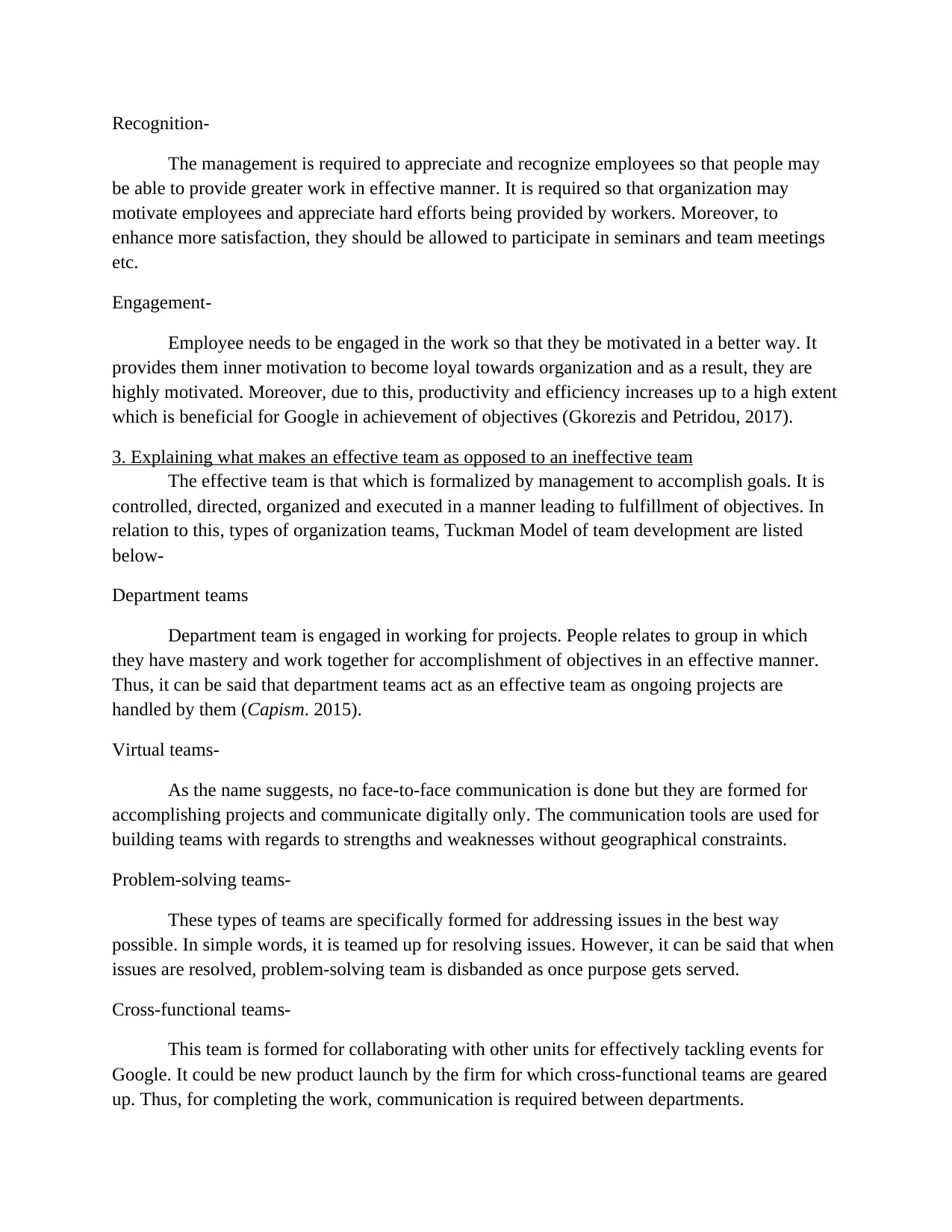
Recognition-
The management is required to appreciate and recognize employees so that people may
be able to provide greater work in effective manner. It is required so that organization may
motivate employees and appreciate hard efforts being provided by workers. Moreover, to
enhance more satisfaction, they should be allowed to participate in seminars and team meetings
etc.
Engagement-
Employee needs to be engaged in the work so that they be motivated in a better way. It
provides them inner motivation to become loyal towards organization and as a result, they are
highly motivated. Moreover, due to this, productivity and efficiency increases up to a high extent
which is beneficial for Google in achievement of objectives (Gkorezis and Petridou, 2017).
3. Explaining what makes an effective team as opposed to an ineffective team
The effective team is that which is formalized by management to accomplish goals. It is
controlled, directed, organized and executed in a manner leading to fulfillment of objectives. In
relation to this, types of organization teams, Tuckman Model of team development are listed
below-
Department teams
Department team is engaged in working for projects. People relates to group in which
they have mastery and work together for accomplishment of objectives in an effective manner.
Thus, it can be said that department teams act as an effective team as ongoing projects are
handled by them (Capism. 2015).
Virtual teams-
As the name suggests, no face-to-face communication is done but they are formed for
accomplishing projects and communicate digitally only. The communication tools are used for
building teams with regards to strengths and weaknesses without geographical constraints.
Problem-solving teams-
These types of teams are specifically formed for addressing issues in the best way
possible. In simple words, it is teamed up for resolving issues. However, it can be said that when
issues are resolved, problem-solving team is disbanded as once purpose gets served.
Cross-functional teams-
This team is formed for collaborating with other units for effectively tackling events for
Google. It could be new product launch by the firm for which cross-functional teams are geared
up. Thus, for completing the work, communication is required between departments.
The management is required to appreciate and recognize employees so that people may
be able to provide greater work in effective manner. It is required so that organization may
motivate employees and appreciate hard efforts being provided by workers. Moreover, to
enhance more satisfaction, they should be allowed to participate in seminars and team meetings
etc.
Engagement-
Employee needs to be engaged in the work so that they be motivated in a better way. It
provides them inner motivation to become loyal towards organization and as a result, they are
highly motivated. Moreover, due to this, productivity and efficiency increases up to a high extent
which is beneficial for Google in achievement of objectives (Gkorezis and Petridou, 2017).
3. Explaining what makes an effective team as opposed to an ineffective team
The effective team is that which is formalized by management to accomplish goals. It is
controlled, directed, organized and executed in a manner leading to fulfillment of objectives. In
relation to this, types of organization teams, Tuckman Model of team development are listed
below-
Department teams
Department team is engaged in working for projects. People relates to group in which
they have mastery and work together for accomplishment of objectives in an effective manner.
Thus, it can be said that department teams act as an effective team as ongoing projects are
handled by them (Capism. 2015).
Virtual teams-
As the name suggests, no face-to-face communication is done but they are formed for
accomplishing projects and communicate digitally only. The communication tools are used for
building teams with regards to strengths and weaknesses without geographical constraints.
Problem-solving teams-
These types of teams are specifically formed for addressing issues in the best way
possible. In simple words, it is teamed up for resolving issues. However, it can be said that when
issues are resolved, problem-solving team is disbanded as once purpose gets served.
Cross-functional teams-
This team is formed for collaborating with other units for effectively tackling events for
Google. It could be new product launch by the firm for which cross-functional teams are geared
up. Thus, for completing the work, communication is required between departments.
Paraphrase This Document
Need a fresh take? Get an instant paraphrase of this document with our AI Paraphraser
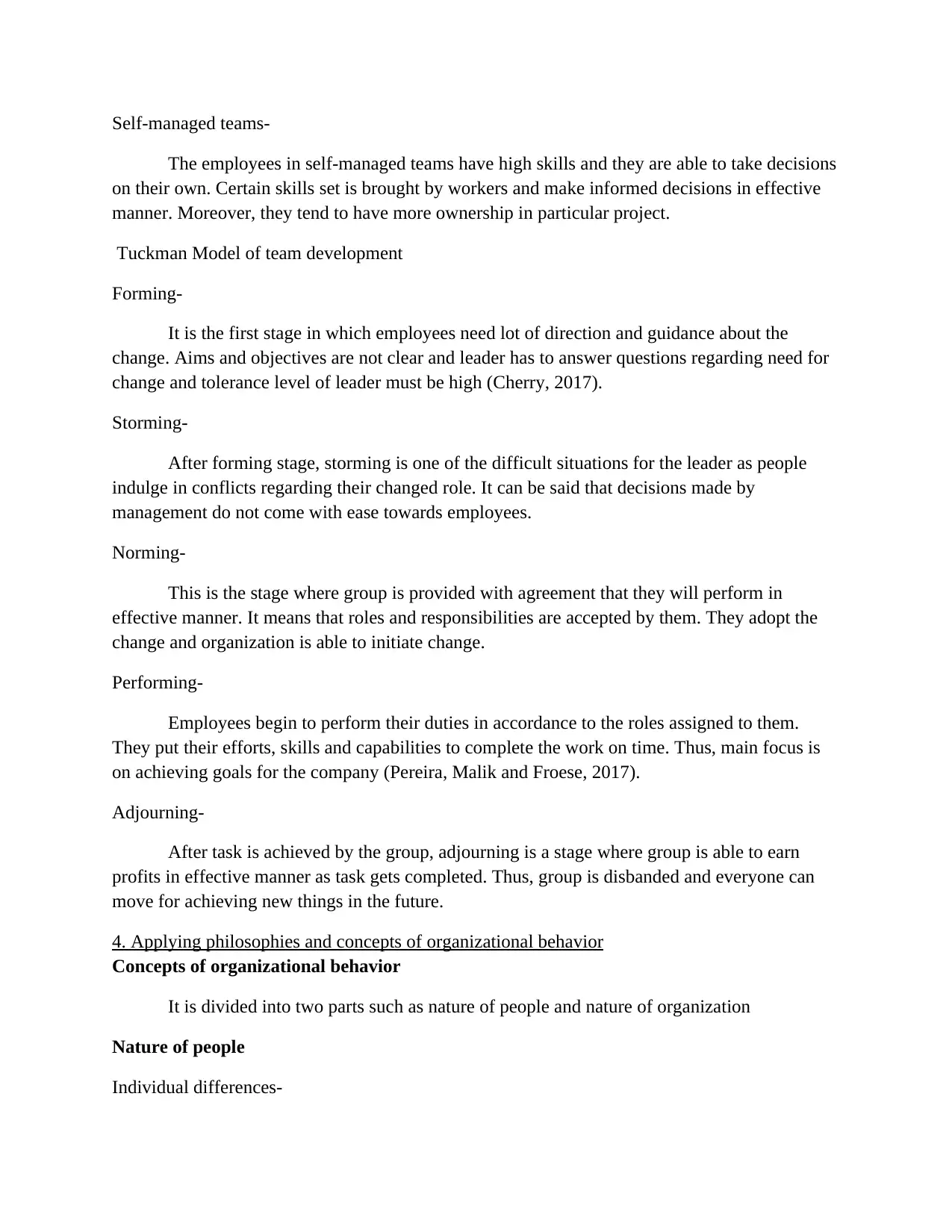
Self-managed teams-
The employees in self-managed teams have high skills and they are able to take decisions
on their own. Certain skills set is brought by workers and make informed decisions in effective
manner. Moreover, they tend to have more ownership in particular project.
Tuckman Model of team development
Forming-
It is the first stage in which employees need lot of direction and guidance about the
change. Aims and objectives are not clear and leader has to answer questions regarding need for
change and tolerance level of leader must be high (Cherry, 2017).
Storming-
After forming stage, storming is one of the difficult situations for the leader as people
indulge in conflicts regarding their changed role. It can be said that decisions made by
management do not come with ease towards employees.
Norming-
This is the stage where group is provided with agreement that they will perform in
effective manner. It means that roles and responsibilities are accepted by them. They adopt the
change and organization is able to initiate change.
Performing-
Employees begin to perform their duties in accordance to the roles assigned to them.
They put their efforts, skills and capabilities to complete the work on time. Thus, main focus is
on achieving goals for the company (Pereira, Malik and Froese, 2017).
Adjourning-
After task is achieved by the group, adjourning is a stage where group is able to earn
profits in effective manner as task gets completed. Thus, group is disbanded and everyone can
move for achieving new things in the future.
4. Applying philosophies and concepts of organizational behavior
Concepts of organizational behavior
It is divided into two parts such as nature of people and nature of organization
Nature of people
Individual differences-
The employees in self-managed teams have high skills and they are able to take decisions
on their own. Certain skills set is brought by workers and make informed decisions in effective
manner. Moreover, they tend to have more ownership in particular project.
Tuckman Model of team development
Forming-
It is the first stage in which employees need lot of direction and guidance about the
change. Aims and objectives are not clear and leader has to answer questions regarding need for
change and tolerance level of leader must be high (Cherry, 2017).
Storming-
After forming stage, storming is one of the difficult situations for the leader as people
indulge in conflicts regarding their changed role. It can be said that decisions made by
management do not come with ease towards employees.
Norming-
This is the stage where group is provided with agreement that they will perform in
effective manner. It means that roles and responsibilities are accepted by them. They adopt the
change and organization is able to initiate change.
Performing-
Employees begin to perform their duties in accordance to the roles assigned to them.
They put their efforts, skills and capabilities to complete the work on time. Thus, main focus is
on achieving goals for the company (Pereira, Malik and Froese, 2017).
Adjourning-
After task is achieved by the group, adjourning is a stage where group is able to earn
profits in effective manner as task gets completed. Thus, group is disbanded and everyone can
move for achieving new things in the future.
4. Applying philosophies and concepts of organizational behavior
Concepts of organizational behavior
It is divided into two parts such as nature of people and nature of organization
Nature of people
Individual differences-
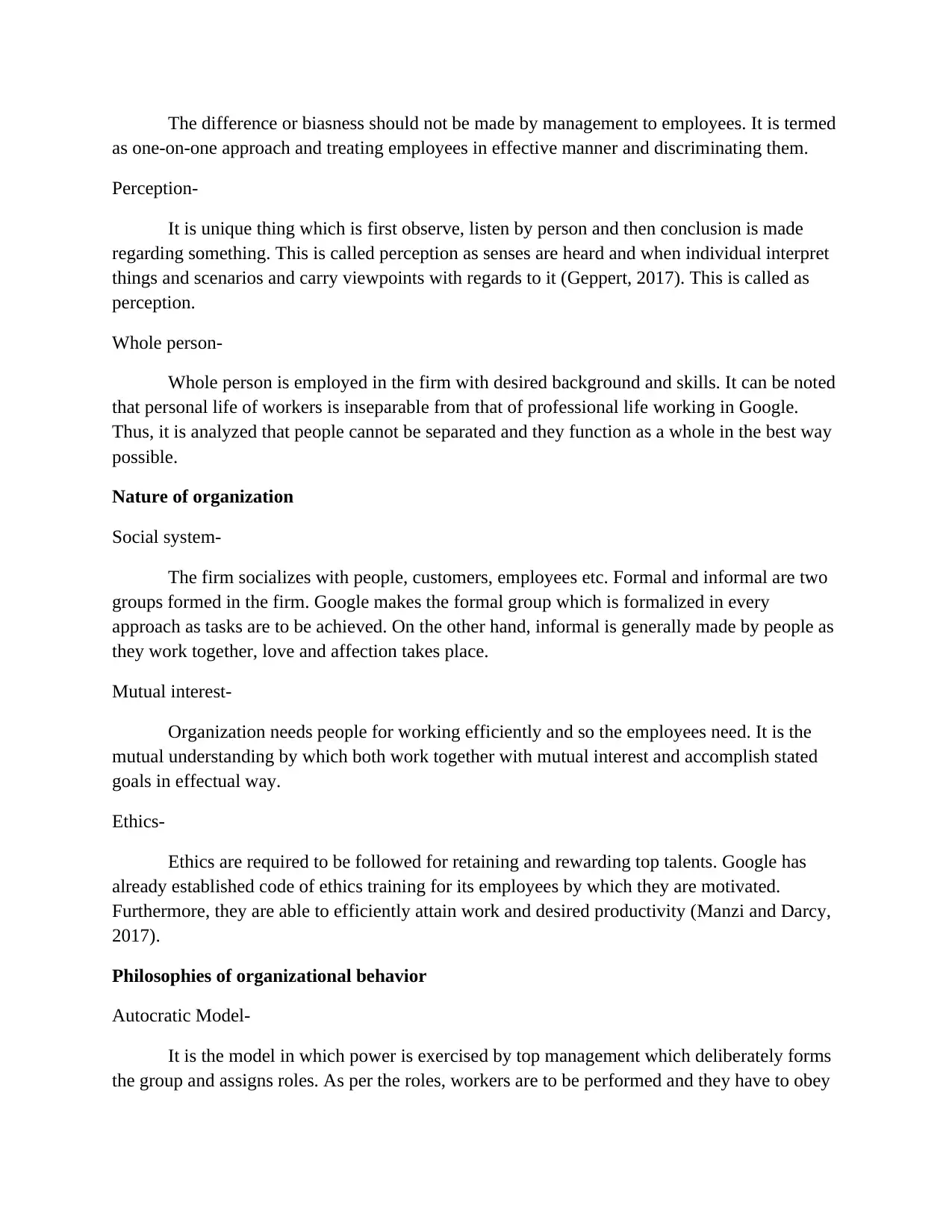
The difference or biasness should not be made by management to employees. It is termed
as one-on-one approach and treating employees in effective manner and discriminating them.
Perception-
It is unique thing which is first observe, listen by person and then conclusion is made
regarding something. This is called perception as senses are heard and when individual interpret
things and scenarios and carry viewpoints with regards to it (Geppert, 2017). This is called as
perception.
Whole person-
Whole person is employed in the firm with desired background and skills. It can be noted
that personal life of workers is inseparable from that of professional life working in Google.
Thus, it is analyzed that people cannot be separated and they function as a whole in the best way
possible.
Nature of organization
Social system-
The firm socializes with people, customers, employees etc. Formal and informal are two
groups formed in the firm. Google makes the formal group which is formalized in every
approach as tasks are to be achieved. On the other hand, informal is generally made by people as
they work together, love and affection takes place.
Mutual interest-
Organization needs people for working efficiently and so the employees need. It is the
mutual understanding by which both work together with mutual interest and accomplish stated
goals in effectual way.
Ethics-
Ethics are required to be followed for retaining and rewarding top talents. Google has
already established code of ethics training for its employees by which they are motivated.
Furthermore, they are able to efficiently attain work and desired productivity (Manzi and Darcy,
2017).
Philosophies of organizational behavior
Autocratic Model-
It is the model in which power is exercised by top management which deliberately forms
the group and assigns roles. As per the roles, workers are to be performed and they have to obey
as one-on-one approach and treating employees in effective manner and discriminating them.
Perception-
It is unique thing which is first observe, listen by person and then conclusion is made
regarding something. This is called perception as senses are heard and when individual interpret
things and scenarios and carry viewpoints with regards to it (Geppert, 2017). This is called as
perception.
Whole person-
Whole person is employed in the firm with desired background and skills. It can be noted
that personal life of workers is inseparable from that of professional life working in Google.
Thus, it is analyzed that people cannot be separated and they function as a whole in the best way
possible.
Nature of organization
Social system-
The firm socializes with people, customers, employees etc. Formal and informal are two
groups formed in the firm. Google makes the formal group which is formalized in every
approach as tasks are to be achieved. On the other hand, informal is generally made by people as
they work together, love and affection takes place.
Mutual interest-
Organization needs people for working efficiently and so the employees need. It is the
mutual understanding by which both work together with mutual interest and accomplish stated
goals in effectual way.
Ethics-
Ethics are required to be followed for retaining and rewarding top talents. Google has
already established code of ethics training for its employees by which they are motivated.
Furthermore, they are able to efficiently attain work and desired productivity (Manzi and Darcy,
2017).
Philosophies of organizational behavior
Autocratic Model-
It is the model in which power is exercised by top management which deliberately forms
the group and assigns roles. As per the roles, workers are to be performed and they have to obey
⊘ This is a preview!⊘
Do you want full access?
Subscribe today to unlock all pages.

Trusted by 1+ million students worldwide
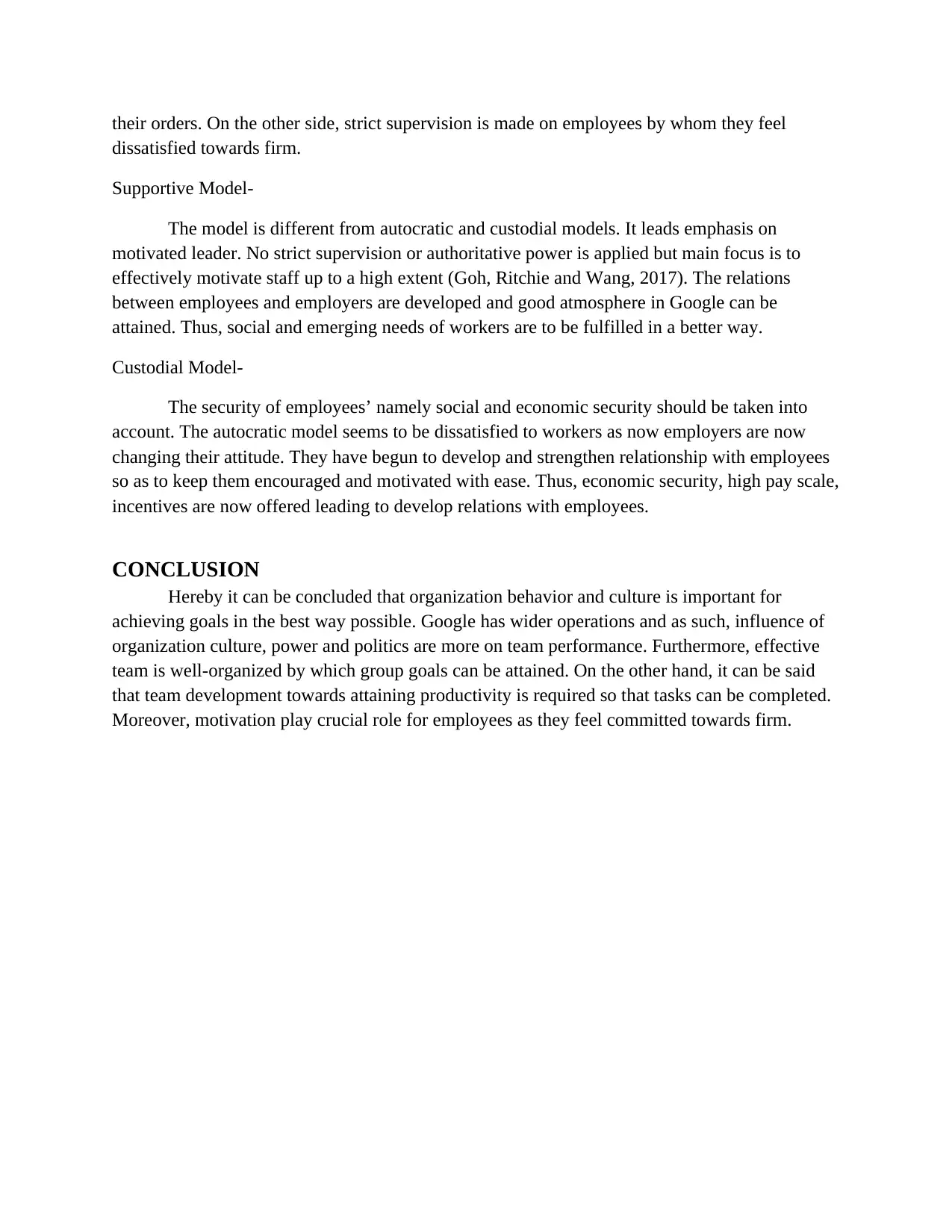
their orders. On the other side, strict supervision is made on employees by whom they feel
dissatisfied towards firm.
Supportive Model-
The model is different from autocratic and custodial models. It leads emphasis on
motivated leader. No strict supervision or authoritative power is applied but main focus is to
effectively motivate staff up to a high extent (Goh, Ritchie and Wang, 2017). The relations
between employees and employers are developed and good atmosphere in Google can be
attained. Thus, social and emerging needs of workers are to be fulfilled in a better way.
Custodial Model-
The security of employees’ namely social and economic security should be taken into
account. The autocratic model seems to be dissatisfied to workers as now employers are now
changing their attitude. They have begun to develop and strengthen relationship with employees
so as to keep them encouraged and motivated with ease. Thus, economic security, high pay scale,
incentives are now offered leading to develop relations with employees.
CONCLUSION
Hereby it can be concluded that organization behavior and culture is important for
achieving goals in the best way possible. Google has wider operations and as such, influence of
organization culture, power and politics are more on team performance. Furthermore, effective
team is well-organized by which group goals can be attained. On the other hand, it can be said
that team development towards attaining productivity is required so that tasks can be completed.
Moreover, motivation play crucial role for employees as they feel committed towards firm.
dissatisfied towards firm.
Supportive Model-
The model is different from autocratic and custodial models. It leads emphasis on
motivated leader. No strict supervision or authoritative power is applied but main focus is to
effectively motivate staff up to a high extent (Goh, Ritchie and Wang, 2017). The relations
between employees and employers are developed and good atmosphere in Google can be
attained. Thus, social and emerging needs of workers are to be fulfilled in a better way.
Custodial Model-
The security of employees’ namely social and economic security should be taken into
account. The autocratic model seems to be dissatisfied to workers as now employers are now
changing their attitude. They have begun to develop and strengthen relationship with employees
so as to keep them encouraged and motivated with ease. Thus, economic security, high pay scale,
incentives are now offered leading to develop relations with employees.
CONCLUSION
Hereby it can be concluded that organization behavior and culture is important for
achieving goals in the best way possible. Google has wider operations and as such, influence of
organization culture, power and politics are more on team performance. Furthermore, effective
team is well-organized by which group goals can be attained. On the other hand, it can be said
that team development towards attaining productivity is required so that tasks can be completed.
Moreover, motivation play crucial role for employees as they feel committed towards firm.
Paraphrase This Document
Need a fresh take? Get an instant paraphrase of this document with our AI Paraphraser
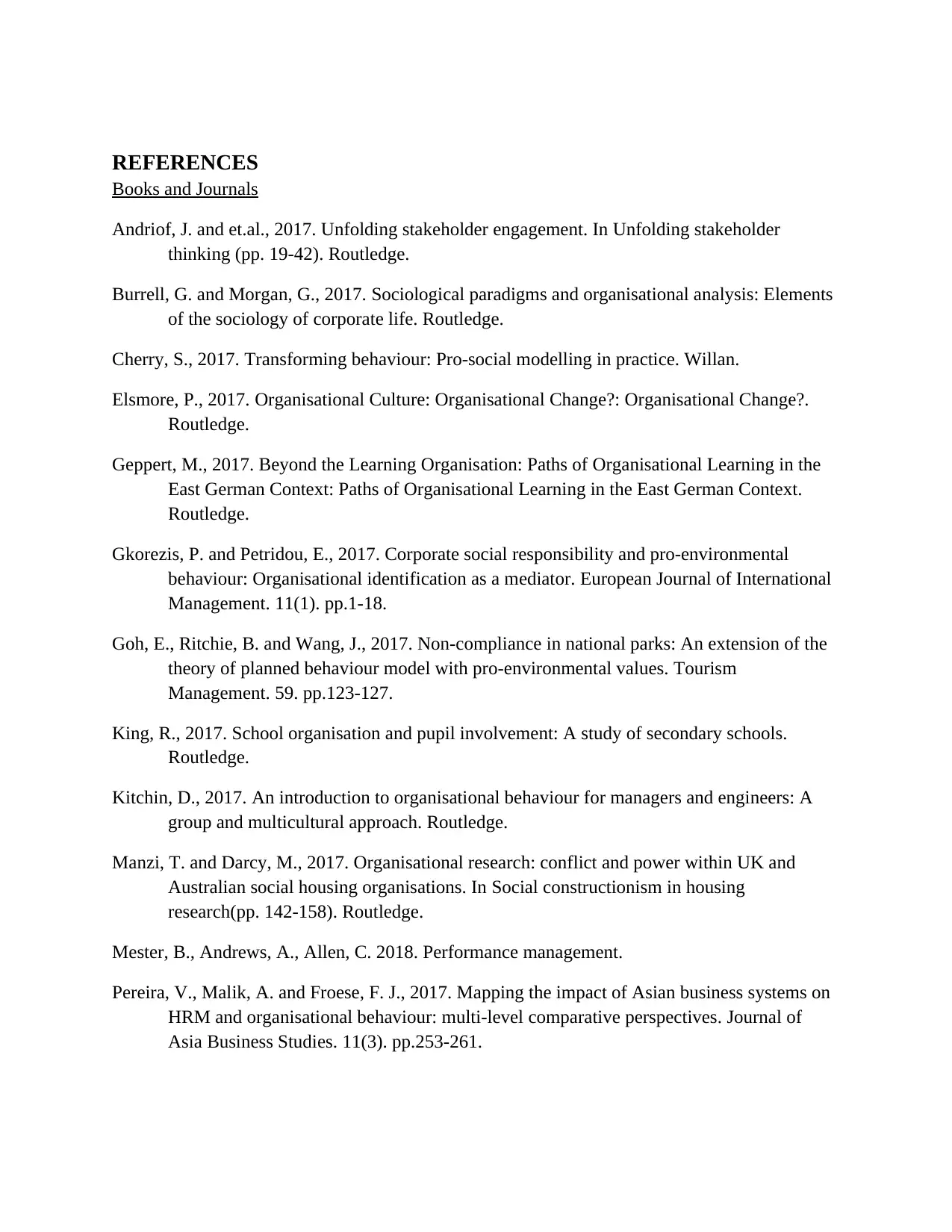
REFERENCES
Books and Journals
Andriof, J. and et.al., 2017. Unfolding stakeholder engagement. In Unfolding stakeholder
thinking (pp. 19-42). Routledge.
Burrell, G. and Morgan, G., 2017. Sociological paradigms and organisational analysis: Elements
of the sociology of corporate life. Routledge.
Cherry, S., 2017. Transforming behaviour: Pro-social modelling in practice. Willan.
Elsmore, P., 2017. Organisational Culture: Organisational Change?: Organisational Change?.
Routledge.
Geppert, M., 2017. Beyond the Learning Organisation: Paths of Organisational Learning in the
East German Context: Paths of Organisational Learning in the East German Context.
Routledge.
Gkorezis, P. and Petridou, E., 2017. Corporate social responsibility and pro-environmental
behaviour: Organisational identification as a mediator. European Journal of International
Management. 11(1). pp.1-18.
Goh, E., Ritchie, B. and Wang, J., 2017. Non-compliance in national parks: An extension of the
theory of planned behaviour model with pro-environmental values. Tourism
Management. 59. pp.123-127.
King, R., 2017. School organisation and pupil involvement: A study of secondary schools.
Routledge.
Kitchin, D., 2017. An introduction to organisational behaviour for managers and engineers: A
group and multicultural approach. Routledge.
Manzi, T. and Darcy, M., 2017. Organisational research: conflict and power within UK and
Australian social housing organisations. In Social constructionism in housing
research(pp. 142-158). Routledge.
Mester, B., Andrews, A., Allen, C. 2018. Performance management.
Pereira, V., Malik, A. and Froese, F. J., 2017. Mapping the impact of Asian business systems on
HRM and organisational behaviour: multi-level comparative perspectives. Journal of
Asia Business Studies. 11(3). pp.253-261.
Books and Journals
Andriof, J. and et.al., 2017. Unfolding stakeholder engagement. In Unfolding stakeholder
thinking (pp. 19-42). Routledge.
Burrell, G. and Morgan, G., 2017. Sociological paradigms and organisational analysis: Elements
of the sociology of corporate life. Routledge.
Cherry, S., 2017. Transforming behaviour: Pro-social modelling in practice. Willan.
Elsmore, P., 2017. Organisational Culture: Organisational Change?: Organisational Change?.
Routledge.
Geppert, M., 2017. Beyond the Learning Organisation: Paths of Organisational Learning in the
East German Context: Paths of Organisational Learning in the East German Context.
Routledge.
Gkorezis, P. and Petridou, E., 2017. Corporate social responsibility and pro-environmental
behaviour: Organisational identification as a mediator. European Journal of International
Management. 11(1). pp.1-18.
Goh, E., Ritchie, B. and Wang, J., 2017. Non-compliance in national parks: An extension of the
theory of planned behaviour model with pro-environmental values. Tourism
Management. 59. pp.123-127.
King, R., 2017. School organisation and pupil involvement: A study of secondary schools.
Routledge.
Kitchin, D., 2017. An introduction to organisational behaviour for managers and engineers: A
group and multicultural approach. Routledge.
Manzi, T. and Darcy, M., 2017. Organisational research: conflict and power within UK and
Australian social housing organisations. In Social constructionism in housing
research(pp. 142-158). Routledge.
Mester, B., Andrews, A., Allen, C. 2018. Performance management.
Pereira, V., Malik, A. and Froese, F. J., 2017. Mapping the impact of Asian business systems on
HRM and organisational behaviour: multi-level comparative perspectives. Journal of
Asia Business Studies. 11(3). pp.253-261.
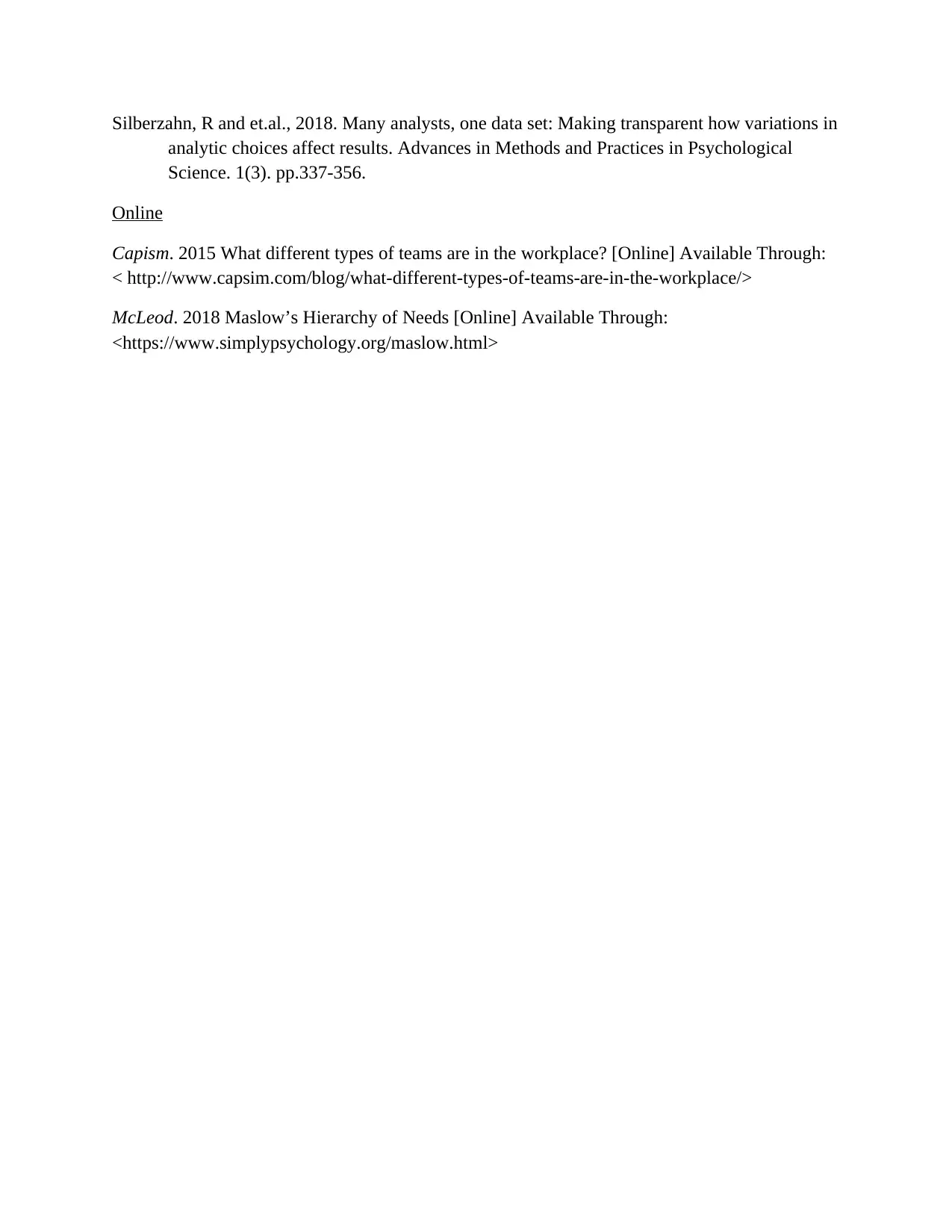
Silberzahn, R and et.al., 2018. Many analysts, one data set: Making transparent how variations in
analytic choices affect results. Advances in Methods and Practices in Psychological
Science. 1(3). pp.337-356.
Online
Capism. 2015 What different types of teams are in the workplace? [Online] Available Through:
< http://www.capsim.com/blog/what-different-types-of-teams-are-in-the-workplace/>
McLeod. 2018 Maslow’s Hierarchy of Needs [Online] Available Through:
<https://www.simplypsychology.org/maslow.html>
analytic choices affect results. Advances in Methods and Practices in Psychological
Science. 1(3). pp.337-356.
Online
Capism. 2015 What different types of teams are in the workplace? [Online] Available Through:
< http://www.capsim.com/blog/what-different-types-of-teams-are-in-the-workplace/>
McLeod. 2018 Maslow’s Hierarchy of Needs [Online] Available Through:
<https://www.simplypsychology.org/maslow.html>
⊘ This is a preview!⊘
Do you want full access?
Subscribe today to unlock all pages.

Trusted by 1+ million students worldwide
1 out of 12
Related Documents
Your All-in-One AI-Powered Toolkit for Academic Success.
+13062052269
info@desklib.com
Available 24*7 on WhatsApp / Email
![[object Object]](/_next/static/media/star-bottom.7253800d.svg)
Unlock your academic potential
Copyright © 2020–2025 A2Z Services. All Rights Reserved. Developed and managed by ZUCOL.





